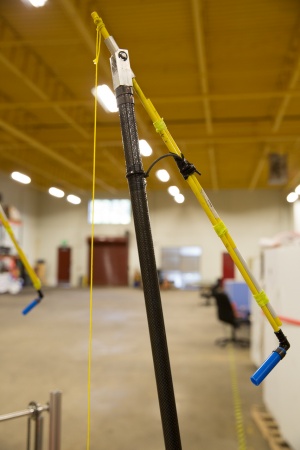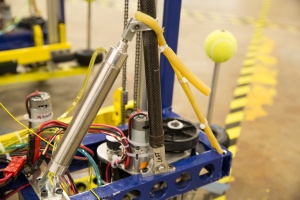Difference between revisions of "DEWBOT XI RC Burglars"
MaiKangWei (talk | contribs) (→RC Burglar Design) |
MaiKangWei (talk | contribs) (→RC Burglar Design) |
||
| Line 11: | Line 11: | ||
==RC Burglar Design== | ==RC Burglar Design== | ||
| − | Two RC Burglars were mounted, one each on the left and right sides of the robot with pivot points close to the front corners. The axes of actuation diverged outward from the robot centerline, allowing the burglars to engage the center holes of either the left or right two Step RCs. | + | [[image:DB11_details_150527-1.jpg|300px|right|thumb|RC Burglar Hook]]Two RC Burglars were mounted, one each on the left and right sides of the robot with pivot points close to the front corners. The axes of actuation diverged outward from the robot centerline, allowing the burglars to engage the center holes of either the left or right two Step RCs. |
The main element of each RC Burglar is a 66" long 0.840"OD x 0.750"ID carbon fiber tube with aluminum clevises glued and swaged into both ends. The bottom clevis engages a bushing block via a 3/8" pin. The bushing block is mounted to the chassis. The top clevis engages a fiberglass rod hook via a 1/4" pin. The fiberglass rod hook directly engages the RC via the top hole. | The main element of each RC Burglar is a 66" long 0.840"OD x 0.750"ID carbon fiber tube with aluminum clevises glued and swaged into both ends. The bottom clevis engages a bushing block via a 3/8" pin. The bushing block is mounted to the chassis. The top clevis engages a fiberglass rod hook via a 1/4" pin. The fiberglass rod hook directly engages the RC via the top hole. | ||
| + | The RC Burglar is extended by extending a 1-1/16" pneumatic cylinder. | ||
| + | |||
| + | A 1/8" nylon cord runs from the back end of the fiberglass hook to the chassis. | ||
| + | [[image:DB11_details_150527-2.jpg|300px|right|thumb|RC Burglar Mount]] | ||
---- | ---- | ||
[[Category:Robot]][[Category:DEWBOT XI]][[Category:Engineering]] | [[Category:Robot]][[Category:DEWBOT XI]][[Category:Engineering]] | ||
Revision as of 21:28, 29 May 2015
We've all done the math. Recycle Containers (RCs) were the key to scoring big in Recycle Rush, and an alliance of solid stackers would win if they were able to control the majority of RCs on the step at the match start. This made a fast RC Burglar which grabbed RCs at the very start of autonomous an essential accessory for a victory-seeking robot.Autonomous Strategies
A quick scoring analysis makes the value of RCs glaringly obvious. If two alliances of competent stackers face each other, the alliance which is able to gain control of the majority of the Step RCs will almost certainly win the match. It's also obvious that the time to gain control of the Step RCs is at the very start of the match; the first second of autonomous period.
In a highly competitive match, two autonomous strategies make sense:
- Fast Can (RC) Burglaring. A robot should secure two RCs from the step during the first second or so of autonomous. In a highly competitive match, it should be assumed that all step RC will be controlled by one alliance or the other during the first second (or so) of the match.
- 3-Tote Autonomous. This is the only autonomous routine which will score points (and significant points at that) during autonomous without reliance on alliance partners
An ideal alliance in a competitive match would comprise two robots having fast double RC Burglars and one robot with reliable 3-Tote Autonomous.
RC Burglar Design
Two RC Burglars were mounted, one each on the left and right sides of the robot with pivot points close to the front corners. The axes of actuation diverged outward from the robot centerline, allowing the burglars to engage the center holes of either the left or right two Step RCs.The main element of each RC Burglar is a 66" long 0.840"OD x 0.750"ID carbon fiber tube with aluminum clevises glued and swaged into both ends. The bottom clevis engages a bushing block via a 3/8" pin. The bushing block is mounted to the chassis. The top clevis engages a fiberglass rod hook via a 1/4" pin. The fiberglass rod hook directly engages the RC via the top hole.
The RC Burglar is extended by extending a 1-1/16" pneumatic cylinder.
A 1/8" nylon cord runs from the back end of the fiberglass hook to the chassis.

